Posts Tagged ‘Development Project’ (13 found)
ေမာင္းမကန္ေက်းရြာသူ/ေက်းရြာသားမ်ား၏သေဘာထားထုတ္ျပန္ခ်က္
ထား၀ယ္ခရုိင္ ၊ေလာင္းလုံးျမိဳ႕နယ္၊ ေမာင္းမကန္ေက်းရြာသည္ လြန္ခဲ့ေသာႏွစ္ေပါင္းတစ္ရာေက်ာ္ကတည္းက
တည္ရွိ ေသာ ေက်းရြာတစ္ရြာျဖစ္ျပီး ေဒသခံအမ်ားစုမွာ ပင္လယ္ငါးဖမ္းလုပ္ငန္းျဖင့္ အဓိကသက္ေမြး၀မ္းေက်ာင္းျပဳကာ လုပ္ ကိုင္လ်က္ရွိေသာ ေက်း ရြာတစ္ရြာျဖစ္သည္ […]
Companies Land Applications Spark Villagers’ Protest Over Disputed Land in Karen State
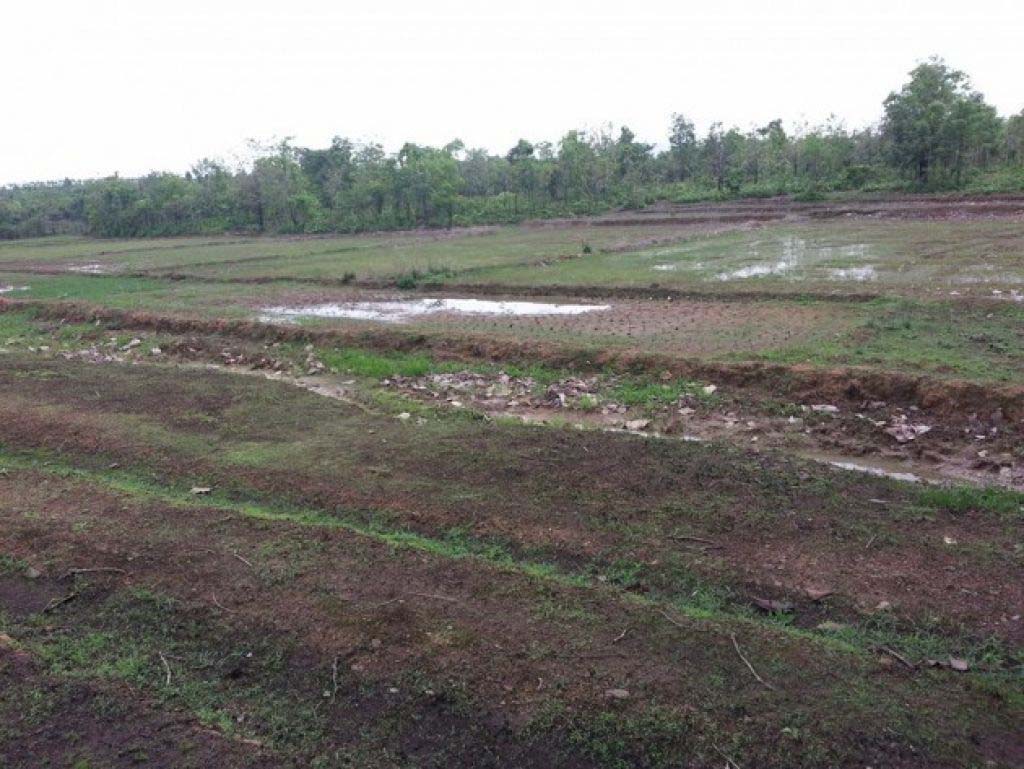 The villagers from Minekan, Hpa-an Township, submitted an letter to the township land registration office on May 27 protesting that applications for permits to grow long-term crops in unclaimed forest land was owned by the local community and was open for investors or companies […]
The villagers from Minekan, Hpa-an Township, submitted an letter to the township land registration office on May 27 protesting that applications for permits to grow long-term crops in unclaimed forest land was owned by the local community and was open for investors or companies […]
Karen Civil Society Rallies Around Japan’s Harmful Plans for Eastern Burma
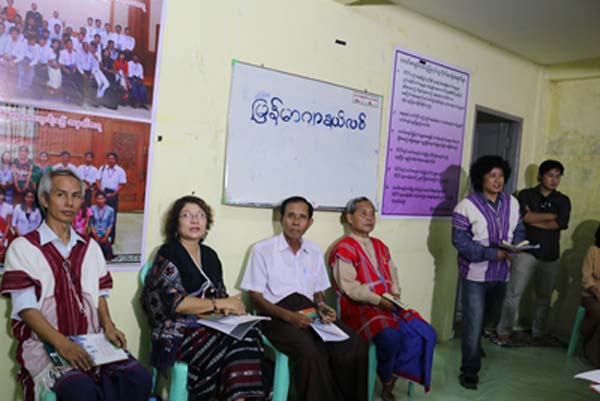 Japan’s lofty development plans for eastern Burma were very publicly rejected by the Karen Peace Support Network (KPSN) at a press conference in Rangoon, citing lack of consultation with communities and the potential for such plans to fuel conflict. Based on a blueprint for extensive development projects produced by the Japanese International Cooperation Agency (JICA), the overseas development arm of the Japanese government, 28 Karen civil society organizations that form the KPSN, released a report to outline their concerns and recommendations. JICA’s blueprint, in which its main goal is to support the return of refugees and internally displaced persons (IDPs), contains four main components; economic corridors, free trade zones and industrial estates, industrial clusters, and urban development. The Japanese government has been working closely with both the Union level and State level Burmese Government in the development of this plan.
Japan’s lofty development plans for eastern Burma were very publicly rejected by the Karen Peace Support Network (KPSN) at a press conference in Rangoon, citing lack of consultation with communities and the potential for such plans to fuel conflict. Based on a blueprint for extensive development projects produced by the Japanese International Cooperation Agency (JICA), the overseas development arm of the Japanese government, 28 Karen civil society organizations that form the KPSN, released a report to outline their concerns and recommendations. JICA’s blueprint, in which its main goal is to support the return of refugees and internally displaced persons (IDPs), contains four main components; economic corridors, free trade zones and industrial estates, industrial clusters, and urban development. The Japanese government has been working closely with both the Union level and State level Burmese Government in the development of this plan.
For Karen civil society, however, there are many concerns, as outlined in the report released on 9 September. Although the blueprint aims to “promote peace through development,” JICA has not conducted a conflict analysis on what is an extremely complicated and fragile context. In fact the plans could serve to exacerbate conflict by facilitating land confiscation, one of the loci of tension in the ceasefire process. Also, improving transport and road access to areas traditionally held by ethnic armed groups such as the Karen National Union (KNU), allows easy access for Burma Army soldiers to the heart of Karen areas. We must not forget the abusive nature of the Burma Army that has been terrorizing civilians for decades and continues to do so, despite a ceasefire in place. Will exposing more communities, who are already vulnerable to abuses, to the unreformed Burma Army really aid peace […]
• • •Economics of Peace and Conflict
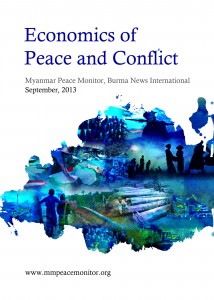 This report aims to clarify the complex processes of solving economic grievances related to the peace process. Examining how these efforts work and how the different actors, policies and projects make up a larger framework may help in assessing how well they respond to the roots of conflict. It especially tries to understand how the many different ministries, committees, international donors, CBOs, businesses (domestic and foreign) and NSAGs work together, overlap, or contradict each other in achieving economic and development goals for national peace […]
This report aims to clarify the complex processes of solving economic grievances related to the peace process. Examining how these efforts work and how the different actors, policies and projects make up a larger framework may help in assessing how well they respond to the roots of conflict. It especially tries to understand how the many different ministries, committees, international donors, CBOs, businesses (domestic and foreign) and NSAGs work together, overlap, or contradict each other in achieving economic and development goals for national peace […]
New Film Calls for Political Dialogue for Lasting Peace in Burma’s Kachin State
To coincide with the International Day of Peace, Burma Partnership launched a new documentary film today entitled, “Guns, Briefcases and Inequality: The Neglected War in Kachin State.” The film demonstrates the need for the government of Burma to engage in meaningful political dialogue with all ethnic nationalities on equal terms, including discussing amendments to the 2008 Constitution. These are necessary in order to address the underlying causes of armed conflict: self-determination, the lack of ethnic rights, and inequality, and to move towards lasting peace throughout the country […]
• • •Shwe Gas Pipeline, A Sign of Things to Come
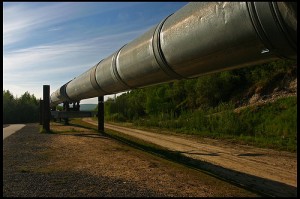 On 28 July, Burma’s Ministers of Energy, the Vice President, the Ambassador of China and a representative from South Korea started the Shwe Oil and Gas Pipeline. It was reported that when the “torches flamed in the sky of Namkham Measuring Station of [Burma]-China Gas Pipeline, a storm of applause and cheers broke out on the ceremony site and Namkham Metering Station.” This image is disturbing: representatives from China, international business and the government of Burma cheered the flames, but no such excitement was felt among the local communities or representatives from social or environmental groups in ethnic areas.
On 28 July, Burma’s Ministers of Energy, the Vice President, the Ambassador of China and a representative from South Korea started the Shwe Oil and Gas Pipeline. It was reported that when the “torches flamed in the sky of Namkham Measuring Station of [Burma]-China Gas Pipeline, a storm of applause and cheers broke out on the ceremony site and Namkham Metering Station.” This image is disturbing: representatives from China, international business and the government of Burma cheered the flames, but no such excitement was felt among the local communities or representatives from social or environmental groups in ethnic areas.
The dual pipelines will travel almost 800km, beginning in Arakan State, passing through Magway and Mandalay Regions and exiting Burma through Northern Shan State. They will cross through various ethnic nationality areas as well as diverse ecosystems, from jungles to mountain ranges.
The pipelines will also traverse ongoing ethnic conflict areas. As recently as April, an international security consultant advised against opening the pipeline due to its path through conflict areas, and warned of the potential for catastrophe […]
• • •Development Projects Fuel Conflict in Ethnic Nationality Areas
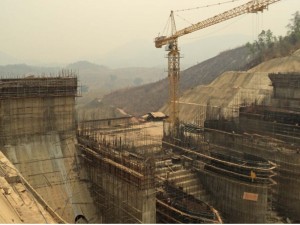 “Local communities and internally displaced persons are concerned that the dam plans will lead to increased militarization, human rights abuses, environmental destruction and loss of local livelihoods,” said the environmental lobby group, China Dialogue, talking about dam construction on the Salween River earlier this week. In recent weeks, there have been several examples of development projects directly contributing to armed conflict and militarization in ethnic nationality areas.
“Local communities and internally displaced persons are concerned that the dam plans will lead to increased militarization, human rights abuses, environmental destruction and loss of local livelihoods,” said the environmental lobby group, China Dialogue, talking about dam construction on the Salween River earlier this week. In recent weeks, there have been several examples of development projects directly contributing to armed conflict and militarization in ethnic nationality areas.
Fighting renewed between the Democratic Karen Benevolent Army (DKBA) and the government-backed Border Guard Forces in late April after the Burma Army ordered the DKBA to leave the area near the Hat Gyi hydropower dam site in Karen State. The DKBA refused to comply. Clashes have ceased but tensions remain high with the Karen National Union Brigade 5 also opposing the construction of the dam […]
Report on the Human Rights Situation (January – December 2012)
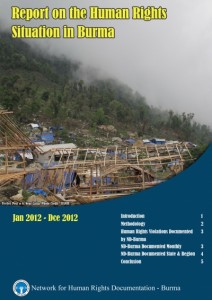 The annual report of Network for Human Rights Documentation – Burma (ND-Burma) documented the human rights situation in Burma from December 2011-January 2013. The report provides information on human rights violations (HRVs) over this period and highlights pressing issues and trends taking place in Burma. The annual report covers human rights violations in 16 categories over all 14 states. Unsurprisingly, the highest incidences of abuse occurred in ethnic nationality areas that remain in open conflict with the Burma Army, the Tatmawdaw, or are the grounds for controversial development projects […]
The annual report of Network for Human Rights Documentation – Burma (ND-Burma) documented the human rights situation in Burma from December 2011-January 2013. The report provides information on human rights violations (HRVs) over this period and highlights pressing issues and trends taking place in Burma. The annual report covers human rights violations in 16 categories over all 14 states. Unsurprisingly, the highest incidences of abuse occurred in ethnic nationality areas that remain in open conflict with the Burma Army, the Tatmawdaw, or are the grounds for controversial development projects […]
Excluded: Burma’s Ethnic Nationalities on the Margins of Development and Democracy
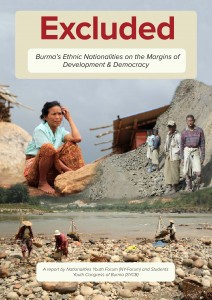 This report presents documented evidence that ethnic nationalities directly affected by development projects in Burma are systematically denied their right to free, prior, and informed consent (FPIC). While development related abuse has been well documented, no report has shed light on the staggering scale of the widespread denial of participation rights in Burma […]
This report presents documented evidence that ethnic nationalities directly affected by development projects in Burma are systematically denied their right to free, prior, and informed consent (FPIC). While development related abuse has been well documented, no report has shed light on the staggering scale of the widespread denial of participation rights in Burma […]
Asian and European Leaders Should Heed Calls for Caution in Myanmar and Place Human Rights and Peace at Center of ASEAN Agenda
Concerns over the viability of various peace initiatives and the hopes of securing long-term peace and stability in Myanmar should be placed high on the agenda of the Asia Europe Meeting (ASEM) in Laos next month, the ASEAN Inter-Parliamentary Myanmar Caucus (AIPMC) said today.
The 9th Asia-Europe Meeting Summit or ASEM 9 will be held on 5 – 6 November 2012 in Vientiane, Lao PDR under the theme: “Friends for Peace, Partners for Prosperity” […]
• • •








 All posts
All posts